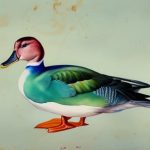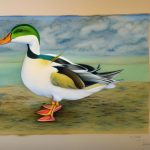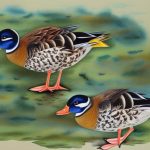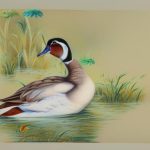Call ducks are a unique and fascinating breed of domestic duck that has been bred for its distinct vocalizations and small size. These ducks are known for their high-pitched “call” which gives them their name. They are often kept as pets, for exhibition, or for their eggs. Call ducks are also popular for their ability to act as “decoy” ducks in hunting, as they can attract other wild ducks due to their vocalizations. These ducks are known for their friendly and sociable nature, making them a popular choice for backyard duck enthusiasts. Call ducks come in a variety of colors and patterns, making them a visually appealing addition to any flock. In this article, we will explore the history and origin of call ducks, their physical characteristics, popular breeds, care and maintenance, as well as their uses and purposes.
Table of Contents
Key Takeaways
- Call ducks are a small domesticated breed of duck known for their distinctive vocalizations and compact size.
- Call ducks originated in the Netherlands and were used as decoy ducks for hunting in the 19th century.
- They are known for their short, stout bodies, round heads, and wide, flat bills, with a variety of color patterns.
- Popular breeds of call ducks include the White, Gray, and Butterscotch varieties, each with their own unique characteristics.
- Care and maintenance of call ducks involves providing a suitable living environment, proper nutrition, and regular health check-ups to ensure their well-being.
History and Origin of Call Ducks
The history of call ducks can be traced back to the Netherlands in the 1600s, where they were originally bred as decoy ducks for hunters. Their small size and distinctive vocalizations made them ideal for luring wild ducks into traps. Over time, call ducks gained popularity as pets and exhibition birds due to their charming appearance and friendly demeanor. They were first imported to England in the mid-1800s and quickly became a favorite among duck enthusiasts. Call ducks were officially recognized as a breed by the American Poultry Association in 1874. Since then, they have continued to gain popularity around the world for their unique characteristics and versatility. Today, call ducks are bred and raised by enthusiasts and breeders who are dedicated to preserving and promoting this special breed.
Physical Characteristics of Call Ducks
Call ducks are known for their small size, with drakes weighing around 1-1.2 pounds and hens weighing slightly less at 0.9-1 pound. They have a compact and rounded body with a short, broad head and a short bill. Their legs are set far back on their bodies, giving them a distinctive upright posture. Call ducks come in a wide variety of colors including white, gray, blue, fawn, and pastel. They also come in various patterns such as bibbed, magpie, and pied. Their most distinctive feature is their high-pitched “call” which is louder and more frequent than other duck breeds. This vocalization is used for communication and is a key characteristic of the breed. Call ducks have a friendly and sociable nature, making them easy to handle and interact with. They are also known for their strong flying abilities despite their small size.
Popular Breeds of Call Ducks
There are several popular breeds of call ducks that are recognized for their unique coloration and patterns. The White Call Duck is one of the most popular breeds, known for its pure white plumage and bright orange bill and legs. The Gray Call Duck is another popular breed, with a beautiful blue-gray plumage and a distinctive white ring around its neck. The Blue Fawn Call Duck is known for its striking blue and fawn coloration, while the Pastel Call Duck has a soft and delicate mix of pastel colors. The Magpie Call Duck is recognized for its black and white pied pattern, while the Bibbed Call Duck has a white bib on its chest with a colored body. Each breed has its own unique charm and appeal, making them a popular choice for duck enthusiasts and breeders.
Care and Maintenance of Call Ducks
Call ducks require proper care and maintenance to ensure their health and well-being. They should be provided with a spacious and secure enclosure that includes access to water for swimming and foraging. Their diet should consist of a balanced commercial duck feed supplemented with fresh fruits, vegetables, and occasional treats such as mealworms or cracked corn. Clean water should be provided at all times for drinking and bathing. Call ducks should be provided with regular veterinary care to monitor their health and prevent any potential illnesses or diseases. They should also be protected from predators such as foxes, raccoons, and birds of prey. Proper shelter should be provided to protect them from extreme weather conditions. Regular grooming and maintenance of their feathers is also important to keep them clean and healthy.
Uses and Purposes of Call Ducks

Call ducks have a variety of uses and purposes that make them a valuable addition to any flock or farm. They are often kept as pets due to their friendly nature and charming appearance. Their small size makes them suitable for smaller backyard setups or urban environments. Call ducks are also popular for exhibition due to their unique coloration and patterns, making them a favorite among poultry enthusiasts. Additionally, call ducks are used as decoy ducks in hunting, as their vocalizations can attract other wild ducks to the area. This makes them an important tool for hunters who use decoys to lure in game birds. Call ducks are also valued for their egg production, as they can lay a good number of small to medium-sized eggs throughout the year. Their eggs are often used for culinary purposes or hatching new ducklings.
Conclusion and Future of Call Duck Breeding
In conclusion, call ducks are a special breed with a rich history and unique characteristics that make them a valuable addition to any flock or farm. Their small size, distinctive vocalizations, and charming appearance have made them popular among duck enthusiasts around the world. As the future of call duck breeding continues to evolve, it is important to preserve and promote the breed through responsible breeding practices and education. By raising awareness about the value of call ducks and their diverse uses, we can ensure that this special breed continues to thrive for generations to come. Whether kept as pets, for exhibition, hunting, or egg production, call ducks have proven to be versatile and valuable birds that bring joy and utility to those who raise them. With proper care and attention, call ducks will continue to enchant and delight duck enthusiasts for years to come.
If you’re interested in learning more about raising poultry, you might also enjoy reading “10 Essential Tips for Building a Chicken Coop” on PoultryWizard.com. This informative article provides valuable insights into creating a comfortable and functional living space for your chickens, which can be especially helpful when considering the specific needs of call ducks. Check it out here.
FAQs
What are call ducks?
Call ducks are a small breed of domestic duck that are known for their distinctive “call” or “whistle” which is higher pitched than other duck breeds. They are often kept as pets or for exhibition purposes.
What are the different breeds of call ducks?
There are several recognized breeds of call ducks, including the White Call, Gray Call, Blue Fawn Call, Pastel Call, Butterscotch Call, and Snowy Call. Each breed has its own unique coloration and markings.
What is the size of call ducks?
Call ducks are one of the smallest breeds of domestic ducks, with an average weight of around 1-1.5 pounds and a height of 9-11 inches.
What is the lifespan of call ducks?
Call ducks have an average lifespan of 5-12 years, depending on their living conditions and level of care.
What are the characteristics of call ducks?
Call ducks are known for their friendly and sociable nature, as well as their distinctive vocalizations. They have a compact, rounded body and a short, broad bill. Their legs are set far back on their bodies, giving them a distinctive upright posture.
What are call ducks used for?
Call ducks are primarily kept as pets or for exhibition purposes. They are also sometimes used for their eggs, which are small but have a rich flavor.
Meet Walter, the feathered-friend fanatic of Florida! Nestled in the sunshine state, Walter struts through life with his feathered companions, clucking his way to happiness. With a coop that’s fancier than a five-star hotel, he’s the Don Juan of the chicken world. When he’s not teaching his hens to do the cha-cha, you’ll find him in a heated debate with his prized rooster, Sir Clucks-a-Lot. Walter’s poultry passion is no yolk; he’s the sunny-side-up guy you never knew you needed in your flock of friends!







